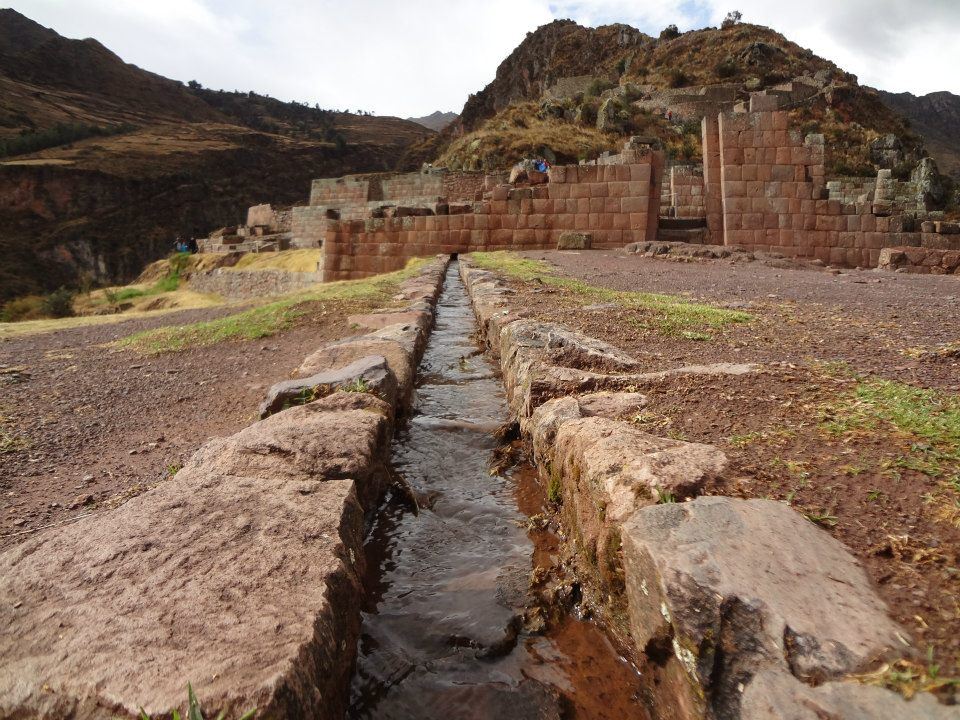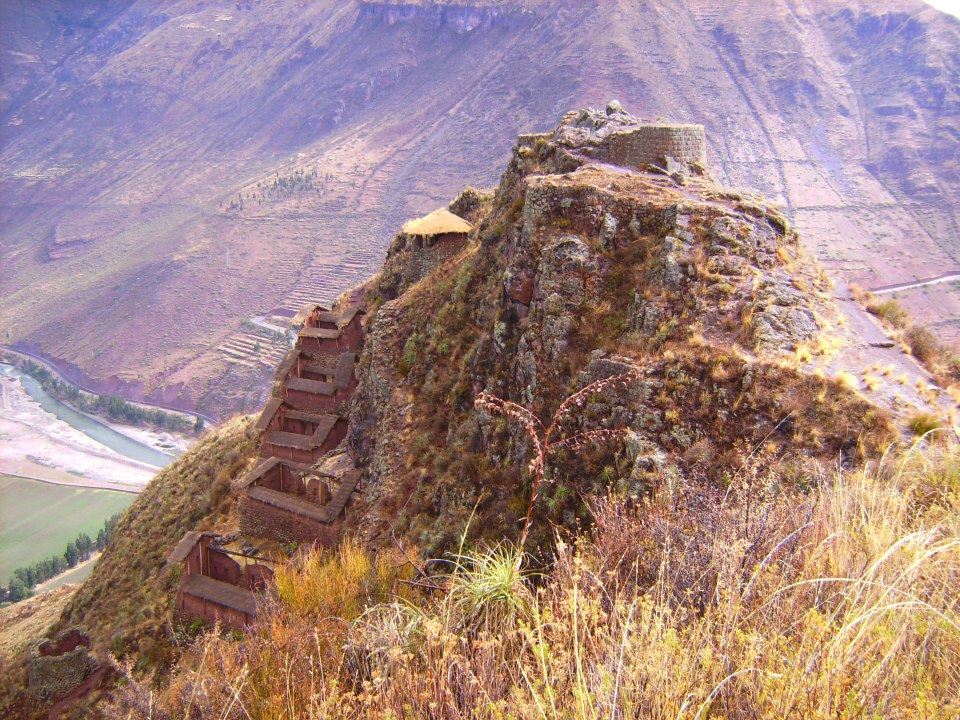The rain crept down the back of my neck, finding its way through my wool ear-flapped hat and underneath the asymmetrical collar of my faux leather jacket. The cool stone, placed here hundreds of years prior, provided just enough shelter from the sideways rain splatters to create a semblance of shelter. My extremely comfortable yet extremely absorbent Ugg boots eagerly let the water trickle through to my toes as the tawny sheepskin seeped to the rich color of coca.
As slippery steps and trackless shoes kept me cornered, my fingertips traced the damp square stones stacked just above head height, fitted seamlessly after they were once willfully lugged by a people better prepared for Andean weather than I.
Pisac is one of many Inca complexes scattered throughout Peru’s Sacred Valley and like several Andean sites its true purpose remains a mystery. Part town, part fortress, part ceremonial center, Peru’s pinnacle pre-Columbian civilization transformed a mountain side overlooking the Urubamba River into one of their largest developments ever. A network of stairwells and expanded natural tunnels connect giant terraces, temples, ceremonial baths, and one of the largest Incan cemeteries, evident today by black holes cutting horizontally into the cliff’s side like small mouths open in a silent scream. Thousands of these tombs line the narrow valleys leading deep into mountain.
Section Type: standardWidthImageS

Pisac lacks the brand awareness and exciting rediscovery of Machu Picchu and can’t compete with Sacsahuaman’s proximity and ease of access from Cusco. And that’s why I love it. Travelers on tight time rarely make it to Pisac; those who've heard of it assume its comparable to the other ruins-and-village combo of Ollantaytambo. Those who do brave the curvy road to this isolated Andean village restrict themselves to the traditional market where hours can be spent browsing for the perfect tapestry or novel indigenous handicraft. The very few who venture up the hill tend to take a taxi. It’s unusual to see anyone other than locals with heavy loads on their backs cambering up the hill the hard way. On foot.
From my perch I squinted through the haze at the minuscule village below, slowing disappearing behind a blur of drops. My unplanned day, sandwiched between altitude adjustment in Cusco and the starting date of our Inca Trail trek, had turned in to a day of simple pleasures as I discovered the allure of Pisac’s abandonment.
However, in hindsight, I should have worn hiking boots and planned for the weather. But when I hopped on a combi (a small local bus) that morning, I hadn’t planned on a big excursion. Especially not one that involved a sixty-plus minute slag up a path steeper than most I’d later encounter on the Inca Trail. But after a delicious brunch consisting of quinoa and purple potatoes, and with the auburn ruins teasing me through the window—situated just far enough and high enough away that I couldn’t estimate their true distance—I decided to bypass the market. Then, when a taxi driver quoted what seems like a disproportionately high price for a ride to the top, I declined. My day was set. Unprepared but up I would go.
The first thing you have to wonder about Pisac is why, with ample valley farmland below, did they choose such an arduous location to build? Mountains held special importance in the Inca culture and, unlike some other Inca towns, Pisac never belonged to a prior civilization. Pisac was likely built in the 1450s under Pachacútec, the Inca ruler who also commissioned Machu Picchu. This means Pisac was put exactly where the Incas wanted it: on the mountains close to the gods. The sprawling complex includes large urban areas for the general, lower-class population and plenty of terraced land for them to work. The stonework changes from functional to fanciful as you transition toward the interior religious zones and dwellings of the elite.
Section Type: standardWidthImageS

The burst of showers dissipated, blowing out as quickly as they blew in, as is common in the Andes. I emerged from my shallow shelter and spent the next several hours in silent awe. No crowds blocked my view of the ceremonial center heavy with solid square stone, gurgling aqueducts, and ceremonial baths. I admired a rare Intihuatana. Called the “Hitching-post of the Sun,” Incan priests used this astronomical tool to calculate solstices and by extension discover the best time to plant and harvest crops. Unlike a similar stone at Machu Picchu, this one wasn’t surrounded by fanny packs and camera flashes.
I spent some time sitting on the edge of a terrace wall, letting my feet dangle into air that met the ground 30 feet below. In the surrounding valley, a river divided the land, its flow necessary for the nurture of the agriculture fields that fed the village, which to me seemed an endless, timeless cycle. Surely some of the locals living below were descendants of those who once lived above. Hundreds of years later and a culture nearly lost, they toiled in nearly the same fashion. Created similar textiles. And remembered the power of the peaks, ever watching, waiting, protecting, from above.
Section Type: standardWidthImageS

There was nothing pretentious about this valley, nothing flashy. Yet as the sun slid to the western side of the sky, the damp ruins caught its changing light and plum juice welled over the far side of the valley as it fell into shadow. And it was brilliant.
Oblivious to the subtle perfection and transcendent palette used to paint their landscape, between my swinging feet I watched tiny human figures—real or a glimpse of the past?—scurry about, packing up the day’s wares. Tarps came down and tapestries packed away. It was time to head home.
All photos belong to author.
Section Type: cta
Keen to see Pisac for yourself? Check out our Peru itineraries or speak to one of our Destination Experts about crafting the bespoke vacation of your dreams.

 South America
South America South America
South America